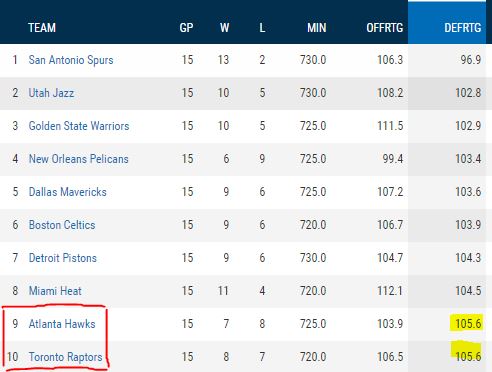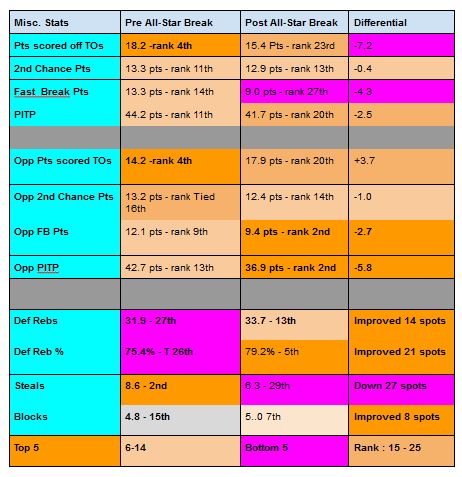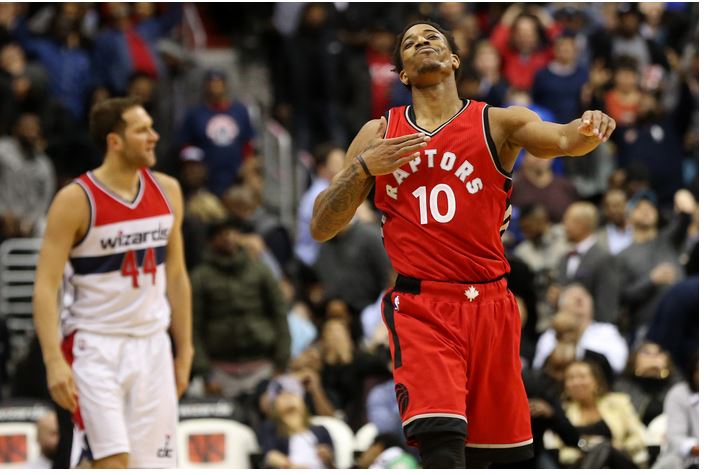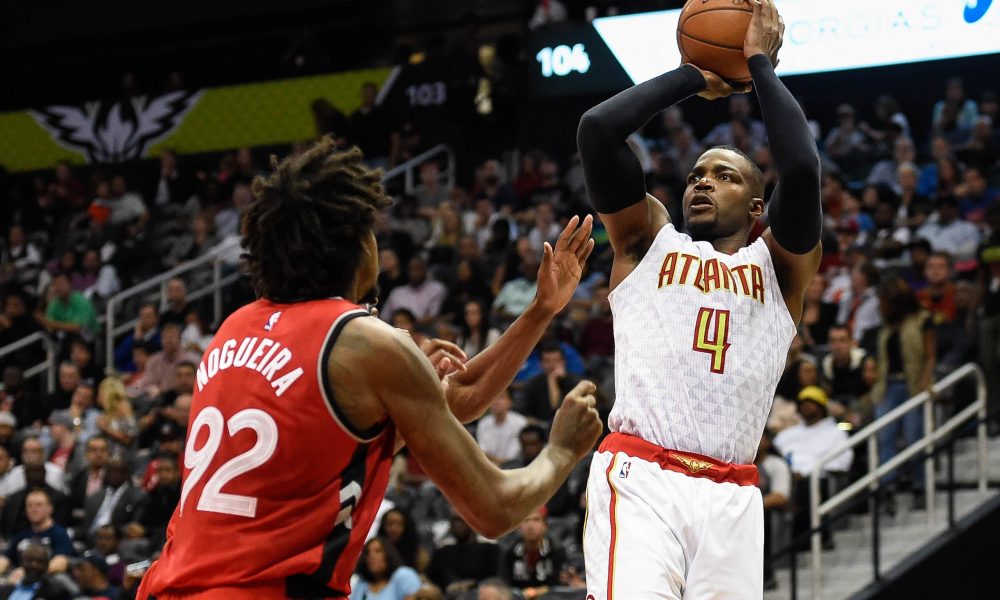With a retooled roster and in spite of the absence of leader Kyle Lowry, the Toronto Raptors have seemingly discovered the most important commodity required to advance in the post season.
Over the course of the 2016-17 NBA season, the Toronto Raptors showcased different iterations of themselves. At season start until mid January the Toronto Raptors sat perched atop the League as the best offensive squad. Eventually the Golden State Warriors usurped them. But, it sure was fun watching the Raptors perform at a historic offensive clip.
Additionally, Toronto endured a heinous early schedule including two massive West Coast trips. By January 9th, the Raptors had completed all but four opposite coast road games (with 11 total WC games remaining). Conversely, two of the upper echelon East Coast squads sat at the opposite end of the spectrum. By the same date (January 9th), the Cleveland Cavaliers had played a mere two games out West and still had 20 games remaining versus their Western opponents. The Washington Wizards had 18 Western Conference games remaining, including two lengthy West trips of five and four games in March.
In terms of adversity, the Raptors benefited from good fortune the past few seasons surviving relatively unscathed. Not so this season with Toronto suffering repeated blows as one player after another hit the infirmary. There was no jarring loss on the scale of what the Milwaukee Bucks have faced losing Khris Middleton for months and then Jabari Parker for the season. Yet, the lengthy absences of Jared Sullinger, DeMar DeRozan, and Patrick Patterson only served to make coach Dwane Casey’s job more taxing. Without the ability to grow the defensive system via constant repetition with established rotations Toronto had difficulty manufacturing a reliable defense.
The Big “D”:
This is not a new narrative for the Raptors. Other than a brief sojourn into defensive prowess a few seasons back, the squad have either struggled to excel consistently, or didn’t have the depth of talent required. Then again, aside from Kawhi Leonard is there a single player who could be tasked with stopping LeBron James? Probably not, so team defense has to be the focus. Moreover, it’s no secret teams who win championships rarely fall outside the top ten defensively (and usually the top five).
With this knowledge in hand and the prospect of needing to stop LeBron James (should the Raptors get to return to the Eastern Conference Finals) Masai Ujiri went to work at the trade deadline. Adding Serge Ibaka and P.J. Tucker filled specific gaps, shored up depth and most importantly added grit and defensively capable players. The resulting effect has been swift. Granted, the loss of Kyle Lowry also precipitated the need for a renewed focus on defense. But, the surprising aspect of this new roster is how quickly the squad has improved in many key defensive categories. Albeit seven games is an extremely small sample size, yet there are constants within that time frame which punctuate where the team is having success.
https://youtu.be/2fe0wJ-JcRs
Shifts in Defensive Ranking:
Of the home court East seeds only the Wizards ranked in the top 10 defensively pre All-Star break. Toronto consistently ranked in the 15 to 18 range, sometimes dipping into the early 20’s. Meanwhile, the Cavaliers had begun their spiral downward defensively, coinciding with a massive scheduling segment of West Coast opponents. By the time the League hit the All-Star Break the top four Eastern Conference teams ranked 9th (Wizards), 16th (Raptors) 18th (Celtics) and 20th (Cavaliers).
Since the break (again, notably with a small sample size) there has been abrupt shifts to these four teams defensive ranking. Isolating on the period of play from February 23rd through games played March 8th two of the home court seeded teams have plummeted south and two have ascended into the top 10.
- Cavaliers rank 29th (114.1)
- Wizards rank (108.6)
- Celtics rank 7th (102.4)
- Raptors rank 9th (103.9)
Signs of Defensive Turn Around:
Although it’s just 7 games there were signs heading into the break the Raptors had gotten on track. Going back 15 games the Raptors had already climbed into the top 10 defensive units, tying Atlanta for 9th best.

Aside from the small sample size there are other signs the Raptors improved defense isn’t simply a misnomer. Three of the seven games played since the break featured top nine defenses. Four of the Raptors seven opponents were also top ten offenses.
Digging further into the stats offers the truest sign of the defensive turn around. Clearly, there has been regression in some areas, no doubt influenced by the loss of Kyle Lowry who any Raptor could play beside and garner a positive on court rating. Cory Joseph has done an admirable job filling in, but he’s not as adept at ball distribution or scoring. And while Joseph’s defense has resembled something closer to what was witnessed last season he doesn’t have the same play making ability or get the steals Lowry does.
Statistical Fluctuations:
All season the two defensive areas the Raptors excelled in was was forcing turnovers and converting those turnovers into points. Likewise the squad ranked high in restricting their own turnovers, and when they did occur the Raptors were successful at limiting teams scoring off those miscues. The chart below showcases those areas. Moreover, it highlights the shift since the break. Clearly the Raptors have regressed in areas they excelled in which is understandable given the loss of Lowry. For example, losing Lowry’s 1.4 steals per game knocks the Raptors to the basement in steals ranking.
That said, the squad has improved in all but two key opponent and defensive categories (the aforementioned steals and opponent points scored off turnovers) .
However, the leaps the Raptors have made in core defensive categories offers some exciting developments. Again, the addition of Ibaka and Turner have been key, but so too has the emergence of DeMarre Carroll, rediscovered defense of Joseph and additional playing time for Norman Powell and Delon Wright has also translated into positive results.

Key Improvements:
- Raptors rank second (previously 9th) for opponent fast break points
- One of the Raptors best defensive improvements is opponent points scored in the paint. They’ve climbed up 11 spots to rank second and have shaved 5.8 points off their previous average. This fact gains further credibility considering it includes games against the Wizards x 2 (10th), and Bucks(1st); both teams who excel at scoring in the paint.
- Defensive rebounding has improved from 27th to 13th
- But the more notable stats is Toronto now ranks 5th (a 21 spot improvement) on defensive rebound percent (meaning the Raptors grab close to 80% of available defensive rebounds.
Note: all stats via nba.com
https://youtu.be/xTaX8iuGo0Y
Room to Grow:
Suffice to say Tucker and Ibaka are still getting acquainted in the system which bodes well for further growth. Assuming Lowry returns in time to establish chemistry with the new players it should result in greater gains. Many are anxious to see the Raptors version of a death lineup with Ibaka moving to center, Patterson at the four, Lowry at the point and any iteration of DeRozan, Joseph, Powell, Carroll or Tucker filling in at the wings.
The other advantage the Raptors hold is they face just one top ten ranked offensive team in their final 18 games, and that comes on the final game of the season (Cavaliers). Toronto makes up for this discrepancy by facing the Hawks, Heat, Hornets, Pistons and Mavericks a cumulative nine times. Those squads all rank top ten defensively. Yet, the glass half full part of me thinks these games will offer opportunities to tweak their own defenses further preparing for the inevitably ramped up playoff defenses.
In Closing:
Ultimately, there is still ample work to be done for the Toronto Raptors and the loss of Lowry can’t be under estimated. That said, entering the stretch, Toronto holds the tie break on both the Wizards and Celtics, have the best record of the East home court seeds since the break, and have arguably the easiest schedule. Now it’s a matter of getting what will be a well rested Lowry back prior to season end.
In retrospect, the crazy part about last season was just how much luck played into the Raptors magical run. From this scribes perspective this version of the Raptors is deeper, wiser, more talented and far more versatile. It’s likely, however, they too will need luck to favor them at some point, as all champions do.
For now, I’m electing to focus on the luck of the schedule, the magic in Ujiri’s magician hat and am choosing to believe Lowry’s absence will provide the precise scenarios the Raptors would never have tested otherwise. And if all else fails, I’ll simply pull out the old standard – – my belief that everything happens for a reason.
In other words, I’m counting on those basketball gods I pray to that this magical era of Raptors basketball is still in it’s infancy and the legacy this core is building – lies ahead.



